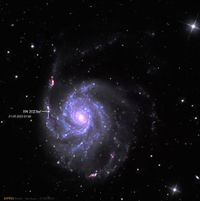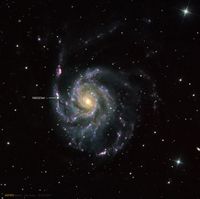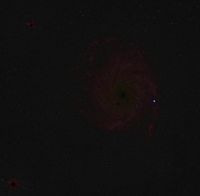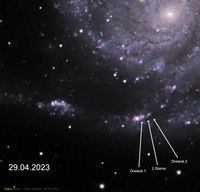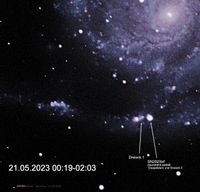M 101 (NGC 5457, Pinwheel-Galaxie oder Feuerrad-Galaxie) ist eine Spiralgalaxie mit den Abmessungen 28,8′ × 26,9′ und der scheinbaren Helligkeit von 7,5 mag im Sternbild Großer Bär. Ihre Entfernung beträgt rund 21 Millionen Lichtjahre, ihr Durchmesser 170.000 Lj. M 101 wurde am 27. März 1781 von dem französischen Astronomen Pierre Méchain entdeckt, der die Position des Objektes an Charles Messier kommunizierte. Messier nahm das ortsfeste, mit bloßem Auge oder geringer Belichtungszeit wie ein Komet wirkende Objekt im gleichen Jahr in die endgültige Version seines Kataloges auf "Nebel ohne Stern, sehr dunkel und groß". Diverse helle Knoten von M101, bei denen es sich um H-II-Gebiete und/oder Sternwolken handelt, wurden später unter separaten Einträgen unter anderem in den NGC aufgenommen.
Bis vor wenigen Tagen wurden vier Supernovae in M 101 entdeckt wie SN 1970G und SN 1975G. Am 19.05.2023 wurde von dem japanischen Amateurastronomen Koichi Itagaki eine neue Supernova SN2023ixf in einem Spiralarm um die Region NGC5462 entdeckt. Der genaue Zeitpunkt (18.05.2023?) der Explosion ist z.Zt. noch nicht bekannt.
In der Nacht vom 20.05. auf den 21.05.2023 war bei uns in MV ein Wolken-Wolkenlücken-Mix und zwischen 0:53 und ca. 2:00 konnten 16 Luminanzframes a 180 s mehr schlecht als recht aufgenommen werden. Um ein vorzeigbares Bild zu erhalten, wurden diese SN2023ixf-Frames mit RGB und Ha Frames von einer Aufnahme vom 29.04.2023 "ergänzt", die SN2023ixf nicht enthielten (s.Bilder anbei). Die SN ist eindeutig zu erkennen, besonders in einem Differenzbild. SN2023ixf wird gegenwärtig weltweit intensiv untersucht. Sie wird sicher sehr rasch ihr Helligkeitsmaximum erreichen. Eine weitere Aufnahme vom 24./25.05. zeigt SN2023ixf augenscheinlich in Größe und Helligkeit wenig verändert zur Voraufnahme. Das Maximum ist wohl schon erreicht.
M 101 (NGC 5457, Pinwheel Galaxy or Pinwheel Galaxy) is a spiral galaxy of dimensions 28.8′ × 26.9′ and apparent magnitude 7.5 in the constellation Ursa Major. Its distance is around 21 million light-years and its diameter is 170,000 light years. M 101 was discovered on March 27, 1781 by the French astronomer Pierre Méchain, who communicated the object's position to Charles Messier. Messier included the stationary object, which looks like a comet with the naked eye or with a short exposure time, in the final version of his catalog "Nebula without a star, very dark and large" in the same year. Various bright nodes of M101, which are H-II regions and/or star clouds, were later included under separate entries in the NGC, among others.
Until recently, four supernovae had been discovered in M 101 so far, such as SN 1970G and SN 1975G. On May 19th, 2023 the Japanese amateur astronomer Koichi Itagaki discovered a new supernova SN2023ixf in a spiral arm around the region NGC5462. The exact time (05/18/2023?) of the explosion is currently not yet known.
In the night from May 20, 2023 to May 21, 2023, there was a mix of clouds and gaps in the clouds in MV (Germany) and between 0:13 and approx. 2:03 16 luminance frames of 180 s could be recorded more badly than well. In order to get an presentable image, these SN2023ixf frames were "supplemented" with RGB and Ha frames from a previous recording of M101 from 04/29/2023, which did not contain SN2023ixf (see images attached). The SN is clearly visible (see detail pictures below), especially in a difference image. SN2023ixf is currently under intensive investigation worldwide. It will certainly reach its maximum brightness very quickly.
M101 "Pinwheel-Galaxie" | |
Teleskop, Montierung, Komakorrektor | TsOptics 10'' (250/1000) Newton, EQ6-R Pro, TSGPU |
Kamera, Guiding | Zwo ASI 1600 MM Pro, guiding Svbony 60/200 mm, Zwo 120mm |
Belichtung, Filter | LRGB 1.25'' TsOptics + Ha Svbony 7 nm (73:17:17:17 + 30 s (7,7 h gesamt) |
Software | N.i.n.a., PHD2, APP, Starnett++, Affinity Photo |
Ort, Datum | Besitz, 26.-29.04.2023 |


